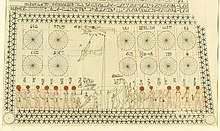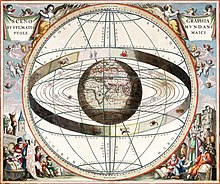Astronomy in Ancient Egypt
The Egyptian astronomy was inseparable from the Egyptian mythology and religion connected, so content the term "Religious Astronomy in Ancient Egypt " is more appropriate. In contrast to Mesopotamian astronomy, it was pursued with a different purpose. The focus was not on the interpretation of omen and the recording of astronomical events, but on the transfer of the divine celestial phenomena to the gods and people of the earth .
The king (only called Pharaoh from 1550 BC ) was the link in this cosmology who no longer saw himself as a normal person on earth during his lifetime. He saw himself as the recipient of the “divine commands from heaven”, which in his responsibility had to be carried out by his court.
The astronomy texts written by the Egyptians had for a long time not received any significant attention in Egyptology . The reasons are to be seen in part with the Egyptologists themselves, who were disappointed in their expectation of being presented with clear descriptions of the sky as in Mesopotamian astronomy. In addition, the writings are very demanding and require the inclusion of Egyptian mythology in their analysis.
Astronomical-cosmological texts
Problems of understanding astronomy
So far, research has mostly focused on the mathematical-scientific aspect of astronomy. Since the determination of stars was associated with great difficulties and the time lag between the data and the first record is usually considerable, a less favorable picture of Egyptian astronomy emerged. However, there is much to suggest that the Egyptians possessed an astronomy that was exact and applicable for the time. The practical relevance was always reflected in religious texts .
Some astronomical historians admit that the ancient Egyptian priest astronomers had a high level of knowledge, but their measurement accuracy was only likely to be around 400 BC. Have reached a level that is comparable to today's level of knowledge. It expressed itself u. a. in determining the exact length of the year to 365.25 days and the orbits of Venus and Mercury.
In contrast, the cosmological concepts were not written for mathematical use or for subsequent generations to provide information about the astronomical arts of the authors. This fact was often ignored, which is why there is hardly any mutual knowledge of the astronomical-religious texts among the Egyptologists. In addition, the relevant materials are often distributed and difficult to grasp, which in the past led to a lack of interest in the closer examination of the corresponding motifs in Egyptology . Many of the Egyptian astronomical texts have not been edited and therefore not published. More recently, a new generation of Egyptologists has devoted themselves to this area, which is why an improved understanding and more extensive evaluations can be expected in the future.
Definition of religious astronomy
Gods can appear both like persons and as heavenly beings. Her work is always dependent on the framework of the cosmic order, which is usually connected with the goddess Maat . People who did not adhere to the given order felt the anger of the sun's eye . In addition, the gods made use of the Chatiu demons and other dangerous messengers of the gods. The Chatiu demons were also active as dean stars in the sky and in the underworld . Together with Ipet-em-pet and Sopdet , they guarded Seth , who, as the constellation Great Bear in the sky, tried to harm the dead Osiris in the embodiment of Orion .
In the religious concept, the goddess Sopdet is considered to be the mistress of the deans , who is also responsible for the birth of the dead deans, who spent seventy days invisible in the realm of the dead , only to appear again born in heaven. Against this background, it is not surprising that the wish was expressed for the deceased to be transferred to the Chatiu. On this basis, the integration of the diagonal star clocks in the coffins becomes understandable, since the deceased was integrated into the life cycle of the other dean stars as the later dean star.
At the same time, the deans are associated with the ancient Egyptian districts and the mummification rites. The deceased was given the promise that his ba could turn into a dean star at will, which in this context was iconographically represented as a bird with a human head. Its functions were varied, as it could either act as a god of protection, wisdom or fate. In this respect, well-known Egyptian deities are concealed behind the dean stars.
The multiple documented statement by ancient authors that the Egyptians only worshiped the stars as gods is based on a misunderstanding. The Egyptians not only worshiped the stars, but also recognized the deities working on earth in the stars and vice versa. For this they used astral interpretations and representations.
As in other early cultures, the alignment of the grave structures according to rise and fall points and the "direction of view" of the dead show astronomical references as well as the connection between fertility and celestial cults.
Development of the heavenly conceptions
The "comb of King Wadji " from the 1st dynasty is considered the oldest evidence of the Egyptian concept of heaven . Decorations of ceilings with simple star patterns can be found for the first time in the Djoser pyramid ( 3rd dynasty ). The cosmology becomes more precisely comprehensible in the pyramid texts , which focus on the ascent of the dead king to heaven. The sky was considered to be the place of the most important deities, who in their initial phase only appeared iconographically in animal apparitions.
The coffin texts of the Middle Kingdom took up the descriptions of the heavenly sphere from the pyramid texts decoratively. The diagonal star clocks on the inside of the coffin lid are particularly striking . The representation of heaven in Heni's coffin , which can also be found later in the graves of the New Kingdom, is unique so far . In general, the previously used strict separation of coffin and pyramid texts can no longer be maintained, as the transitions are fluid and motifs from the Old Kingdom can also be found later .
Under Sesostris III. One dedicated oneself to the restructuring of the so-called Groove Book , which the Egyptians called "Plan of the course of the stars" and whose beginnings are dated to the Thinite Age (beginning of the third millennium BC). The archaeological find for the New Kingdom in the temples and graves is much better documented than in prehistoric times. However, it cannot be concluded from this whether the preoccupation with the phenomena of heaven was intensified during this time. Science and religion were still connected as one unit. The newly invented water clocks adorned the astronomical displays. Similar cosmological references are present in the day dialing calendars .

The books of the day and the book of the night as well as the Nut book appear for the first time in the royal tombs . The continuation of cosmological variants can be seen in the third interim period , which in this context concentrated particularly often on the Geb - Nut motif. The temples and graves of the late period are mostly so destroyed that it is hardly possible to make reliable statements about the further course. In addition, almost entirely preserved papyri are missing . However, the few surviving tombs of the 25th and 26th dynasties as well as coffins of the last indigenous dynasties up to the Ptolemaic period continue to show the great popularity of astronomical motifs in connection with the sky books.
Increasingly in the sixth century BC Influences in the sky representations with a divinatory background to notice, which was certainly related to the entry of the Zodiac from Babylonia. The intensive contact with the Nubian 25th dynasty transferred Egyptian ideas to Meroe . In the Greco-Roman times there were again a particularly large number of finds of heavenly images in the temples. In addition to astrological texts , the sky books were also used unchanged.
Zodiac performances are now finding their way into Roman graves and coffins . The large number of revisions to old cosmological specifications is remarkable, the hieroglyphs of which could no longer be used, but could be read. With the end of the Pharaonic-Egyptian culture and the decline of the Egyptian temples, the images of heaven, which can only be found in rudimentary form in the Coptic liturgy or, in individual cases, were able to save themselves into the Renaissance , before they lost their traces in Arab times , also mostly disappeared .
The cosmological creation
In the New Kingdom, the ideas about the creation of the world are shown for the first time decoratively on the temple and grave walls. In the tomb of Ramses III. Excerpts from the gate book and the book from the earth adorned the sarcophagus hall , in the side room scenes from the book of the celestial cow , from which the priests recited the cosmological creation on the days of the new and full moon :
“The fathers and mothers were together with Re in the primordial waters Well , from which Re arose by itself and held kingship when humans and gods were still united. When Re went to his palace on the back of the celestial cow, the earth was dark. So Re said to Nut : “I am the one who shines, I am who I am and have sat on your back to exalt myself.” At Her Majesty's command, Nut transformed into the inhabitants of the underworld and starry sky , the she was at the same time herself. Re looked into it (the void in Nut) and Nut said: “Equip me with all kinds of things.” So Re first created the stars , then the sacrificial and rush landscapes . Then Re created the stars that never set. Nut began to sway because of the great height. Then the Heh gods came into being , who support them as pillars of heaven and are keepers of the stars. Shu , the son of Re, placed himself under his sister Nut as protection of the Heh gods. As a nurse, she (Nut) raises the stars, which are always reborn in the twilight and embraced by Schu. That is why his name is placed between the stars. A boat with a rudder is in the groove, the sun disk on top of it. The scepter of heaven is between her thighs . Re appointed Thoth as his deputy in the night sky and in the underworld, for Thoth is luminous like Re. This is how the moon came into being . The priests are to read the ancient prescriptions of the old gods in purity on the first and fifteenth days of the month. "
Astronomical constellations
At the beginning of the fourth millennium BC In ancient Egypt, different astronomical constellations prevailed than, for example, in the 20th century. Because of the precession , today's Pole Star was far from the celestial pole and was not yet a circumpolar star . In the Nile Delta , he remained only from v 3,733th Continuously visible in the sky and in Elephantine from 2326 BC. The celestial pole represented around the year 2830 BC. The star Thuban in the constellation Dragon .
The assignment of the constellation “ bull's legs ” to the desert god Seth can only have been made from the Old Kingdom onwards, since the mythological role assigned to him was previously not given astronomically. It is noteworthy that the constellation of Seth was the only constellation in the sky that did not perish in the history of the ancient Egyptian dynasty.
To determine the time at night, twelve circumpolar night stars were used , with the length of the first and last time segments being adapted to the season .
In the pyramid texts, the 12 "immortal stars in the north that never set" were precisely described. This theological-cosmological principle of order was also present in the erection of the pyramids , the alignment of which was always based on the "immortal stars in the north". The interpretation of the principle of order was based on the mythological equation of north and west in connection with the sunset , since the sun in the west sinks below the horizon and is then no longer visible. The same invisibility is given for the north and northeast.
For the south, the connection between the midday position of the sun and its rise in the east applies symbolically for visibility during the day. The explanatory pattern thus consists of east / south = day and west / north = absence of the sun = night. The alignment of the shafts and burial chambers followed this principle, whereby the "immortal stars in the north" were also integrated into the cosmological explanatory pattern described.
Introduction of the Babylonian Zodiac
The astrological terminology appeared in the late Egyptian period in the demotic language and was based on the ancient Egyptian records. In the early days, omen-like evaluations were only occasionally associated with the respective sky segments. For example, solar and lunar eclipses have been described as "swallowing the sky".
Traditionally, the emergence of astrological concepts has been associated with Mesopotamia and Greece , but Egypt has been marginalized. The analyzed Egyptian text material points in a different direction. The Mesopotamian writings first reached Egypt and mixed with religious and astronomical models from Alexandria . A clear example are the symbols of the zodiac signs, which are still in use today, which are well documented in demotic sources, and initially only very sporadically in Greek. Another clear case is with the deans .
Presumably in the late period a twelve-part system developed which, like the doctrine of deans, merged with the zodiac astrology adopted from Mesopotamia. In this development phase, two competing naming systems were still in use: “Awi N” as “House of N” and “Niet N” as “Part of N”. Both forms influenced terminology in other languages.
The Egyptian astrological terminology is very well attested in Demotic, Greek and Latin languages as well as in Sanskrit . In the Mesopotamian area, however, these forms are unknown. Therefore, only the Egyptians come into question as "inventors" of the special text structure. Formulations and sentence structure also refer to the typical patterns in the pyramid texts. The findings of the Nut book show further similarities. In addition, there is the fact that the ancient astrological treatises always trace the teachings back to Egyptian authors. Otto Neugebauer therefore describes Egypt as the "cradle of Hellenistic astrology , which then spread from Egypt over the whole world".
See also
literature
- Erik Hornung : The Egyptian myth of the heavenly cow. An Etiology of the Imperfect. Vandenhoeck & Ruprecht, Göttingen 1982, ISBN 3-7278-0262-6 .
- Rolf Krauss : Sothis and moon dates: studies on the astronomical and technical chronology of ancient Egypt. Gerstenberg, Hildesheim 1985, ISBN 3-8067-8086-X
- Christian Leitz : Studies on Egyptian Astronomy. Harrassowitz, Wiesbaden 1991, ISBN 3-447-03157-3 .
- Christian Leitz: Ancient Egyptian star clocks. In: Ernst Seidl u. a .: The sky. Ideal image and understanding of the world. MUT, Tübingen 2011, pp. 161-170.
- H. Roeder: "On the wings of Thoth" The crest of King Wadj and his motifs; Topics and interpretations in the pyramid texts . In: Mechthild Schade-Busch: Open Paths. Festschrift for Rolf Gundlach on his 65th birthday. Harrassowitz, Wiesbaden 1996, ISBN 3-447-03879-9 , pp. 232-252.
- Alexandra von Lieven : The sky over Esna. A case study of religious astronomy in Egypt using the example of the cosmological ceiling and architrave inscriptions in the Temple of Esna. Harrassowitz, Wiesbaden 2000, ISBN 3-447-04324-5 .
- Alexandra von Lieven: Floor plan of the course of the stars. The so-called groove book. The Carsten Niebuhr Institute of Ancient Eastern Studies (among others), Copenhagen 2007, ISBN 978-87-635-0406-5 .
- Massimiliano Franci: Astronomia egizia, Introduzione alle conoscenze astronomiche dell'antico Egitto. Edarc, Firenze 2010, ISBN 978-88-86428-94-1 .
Remarks
-
↑ In particular, note the equation of the zodiac sign Libra with the horizon hieroglyph
referenced.
Individual evidence
- ↑ For example Abel Burja : Textbook of Astronomy. 1787, p. IX: The astronomical knowledge of the Egyptian priests seems to go back to a very high antiquity ... Only about 400 years BC. did they make more noticeable progress ... That the year, which they had previously given only 365 days, contained 6 hours more. They also discovered that Venus and Mercury moved around the sun as it circled the earth.
- ↑ Alexandra von Lieven: Floor plan of the course of the stars - The so-called groove book . Copenhagen 2007, p. 166; Serge Sauneron et al .: Rituel de l'embaumement, pap. Boulaq III, pap. Louvre 5.158. Imprimerie nationale, Kairo 1952, pp. 24.12-25.1 and 29.5-8.
- ↑ Jürgen Hamel : History of Astronomy: in texts from Hesiod to Hubble. 2nd revised and expanded edition, Magnus, Essen 2004, ISBN 3-88400-421-2 , p. 13f.
- ↑ Alexandra von Lieven: The sky over Esna. A case study of religious astronomy in Egypt using the example of the cosmological ceiling and architrave inscriptions in the Temple of Esna . Wiesbaden 2000, p. 12.
- ^ Christian Leitz: Studies on Egyptian Astronomy. Wiesbaden 1991, p. 49.
- ↑ Patrick Moore: The Observer's Year 1998, ISBN 978-3-540-76147-1 , doi : 10.1007 / 978-1-4471-3613-2 .
- ^ Otto Neugebauer: A history of ancient mathematical astronomy. Springer, Berlin 1975, ISBN 3-540-06995-X , p. 607.




